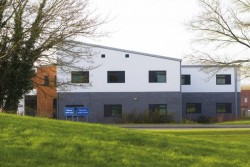Helen Revitt, Regional Director and Health Sector Lead at architecture and building consultancy AHR, explains why the healthcare sector is increasingly embracing modular solutions.
Design for offsite construction - and the rebirth of modular as a sought-after delivery mechanism for high-quality buildings - is a development that has inspired much debate.
There are several reasons for the resurgence of modular construction but there are two especially important factors, which are particularly important to take note of. Firstly, the need to deliver increased capacity across sectors including healthcare, housing and education has become increasingly urgent. Secondly, the Government's vision for the future of construction - as outlined in its Construction 2025 strategy - mandates targets that the adoption of modular construction is well-suited to help achieve.
These big-picture issues have become prevalent while the quality of modular building has improved. Whereas the pre-fabricated housing of the post-War era created a stigma around off-site manufacturing and modular as a construction method, advancements in technology have enhanced our ability to harness the advantages offered by a controlled factory environment - and the result is high-quality buildings.
These improved solutions have not gone unnoticed in the healthcare sector. We have seen increasing support from both Government and senior leadership within the sector for the use of modular buildings to address the huge demand for increased capacity. Consequently, many of the new wards and operating theatres we see are likely to be modular - and with good reason.
One of the well-publicised benefits of modular is that it allows for the creation of repeatable elements. This dynamic is ideally suited for the healthcare sector - as many of the structures required need to be designed and built to meet set dimensions. The delivery of a high volume of wards, for which the dimensions remain the same, is a good example of the type of project for which a modular approach can drive significant benefits. Modules can be uniformly designed to accommodate necessary M&E works and, when delivered at scale, significant efficiencies in cost and time can be achieved.
At a time when the health sector faces a huge amount of pressure, meeting expected construction timescales is another important consideration. Traditional processes, with construction taking place on-site, are subject to delays often beyond the control of the contractors involved. Bad weather, for example, can slow progress on site and result in projects being delayed. With offsite construction, these potential problems can be negated.
Conducting work in a factory-controlled environment means problems associated with on-site construction can be nullified and health and safety standards for workers improved. Health and safety concerns at the healthcare estates where new buildings are being delivered can also be reduced due to the fact construction-related hazards are present for a limited time period. This reduction in time on-site also helps to minimise disruption to both patients and staff, who need to be able to continue to use the premises while work is delivered.
Working in a controlled environment also means the quality of the materials delivered can often be higher. In addition to this, the sustainability of the construction process in modular projects can also be improved. The opportunity for recycling to take place within the factory during construction is one aspect to this. Another is the reduction in the noise pollution typical across traditional construction sites.
These sustainability benefits continue from the production process, through to the performance of the buildings themselves. When paired with effective heat recovery and ventilation technology to mitigate the airtight nature of the construction, the use of a modular typology can create healthcare estates with industry-leading energy standards.
A further important facet of modular construction is the incorporation of Building Information Modelling (BIM) and the cooperation between architects and contractors this technology requires. The use of BIM is significant in modular projects because this technology allows for digital incarnations of the built environment to be realised prior to its physical construction - with all the key components of the building clearly specified.
This is crucial in a modular context, as it allows for greater confidence to be fostered among stakeholders - for whom a modular approach may be unfamiliar. There is greater certainty around what the delivered elements will be, how they will look, the standard to which they will perform, and the way they will integrate within the existing estate. As decision makers become increasingly aware of modular solutions - this high level of insight is important in building confidence in the approach and its suitability.
The adoption of modular construction also opens up a new option through which architects and construction firms can deliver new buildings for healthcare estates. The increased capacity for delivery that modular alongside traditional construction offers is a key development at a time when the pressures upon the healthcare sector are great.
The cumulative force of these benefits combined helps to explain why modular is increasingly popular generally, and why it is particularly appropriate within the context of healthcare. With widespread support that continues to grow - it may be no exaggeration to say the future of healthcare is modular.
For more information visit www.ahr.co.uk
Original link - PSBJ









